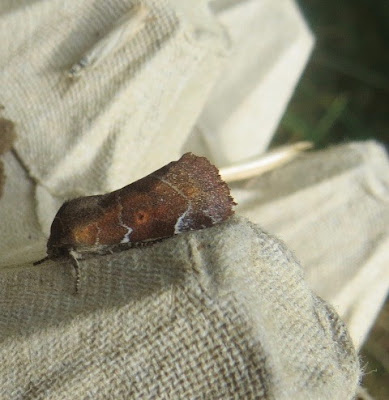Thursday evening began with a bit of birding. I popped down to the flash field on the back of the UK's hottest ever day (until next year probably). It was a bit dull if I'm honest, a couple of Green Sandpipers, and 26 Lapwings. I did at least see the Kingfisher heard last Sunday.
So on to the mothing. I struggled across a couple of George's fields to the small copse jutting out from Bannam's Wood where he suggested I could site my trap. After a bit of a struggle in fading light I got the trap up and stepped back to the realisation I had forgotten the egg boxes! What a professional. 30 minutes later I had returned from home, stuffed them in, and plugged it in to the light sensitive battery. It came on immediately. Phew.
Now I know I was supposed to hang around until the wee small hours, swishing away with a net and periodically peering into the trap. Actually I don't know this, but I get the impression that that is what is generally done. What I did was go home and get a good night's sleep.
The hot night produced several moths in the bathroom, including a new pyrallid species, but I'll tag those onto the end of this post.
I arrived back the following morning, relieved it was not raining, and marched to the trap. It was full of moths, and indeed the surrounding area also had loads crawling about. The next six hours were somewhat manic, back-breaking (I must bring a chair next time), and often confusing. Very early on I "lost" my only pencil and had to go to the farm to borrow a pen. I found the pencil in a reference book almost as soon as I got back.
 |
| Moths galore |
I don't propose to list every moth species here, but they are all detailed in the 2019 Moths at Morton Bagot page. I can begin however by listing the top 12 in terms of numbers. The catch was dominated by the grass moth Chrysoteucha culmella, also known as the Garden Grass-veneer.
Garden Grass-veneer - 286
The Uncertain/Rustic - 43
Large Yellow Underwing - 15
Smoky Wainscot - 13
Dun-bar - 10
Agapeta hamana - 9
Lesser Yellow Underwing - 9
Riband Wave - 9
Clay - 8
Double Square-spot 6
Ruby Tiger - 6
Common Rustic ag - 6
I normally try to distinguish the moth called the Uncertain and the very similar Rustic, but a high proportion were rather worn and so I didn't bother. The Uncertain is far commoner in our garden, and I think they dominated here, but some may have been Rustics.
I had expected to see a large number of new moths, but in fact most of the ones I saw had occurred at some point over the last couple of years in the garden. There were some new ones though, and potentially a couple of scarce moths.
The first one which I knew was something I had never seen before was a Brown-line Bright-eye, in fact I caught three of them.
 |
| Brown-line Bright-eye |
In Warwickshire Moths it is described as widespread and fairly common. Another tray contained an extremely attractive micro called a Brown China-mark.
 |
| Brown China-mark |
Shortly afterwards I spotted a Pinion sp and assumed it would be a Lunar-spotted Pinion (the only species of Pinion I had seen in my garden) so I photographed it and moved on. It was only later that I realised it looked more like the much scarcer Lesser-spotted Pinion.
 |
| Lesser-spotted Pinion |
Another tray contained a cryptically marked moth which had me very confused for a long time. I thought it might be a moth called Confused, until a trawl of the Internet came up with the more plausible identification of Straw Underwing.
 |
| Straw Underwing |
Not so my last moth of interest, and this time I was alive to the possibilities and photographed it upside down in order to demonstrate it was not the relatively common Yellow-tail (I caught one of those too), but the much scarcer Brown-tail.
 |
| Brown-tail |
It took the entire morning to go through the trap. It also contained a wasp (just one!) and quite a few earwigs and beetles. Judging by the evidence of several half-eaten moth corpses in the bottom of the trap, some of the latter were carnivorous.
I heard a variety of woodland birds, and a distant singing Yellowhammer I'm delighted to say.
Back to garden, the new one was Acrobasis consociella, and new for the year were Cloaked Minor, Single-dotted Wave, and Dun-bar.
 |
| Acrobasis consociella |
Postscript: David Brown has confirmed both the Lesser Spotted Pinion and the Brown-tail.
No comments:
Post a Comment